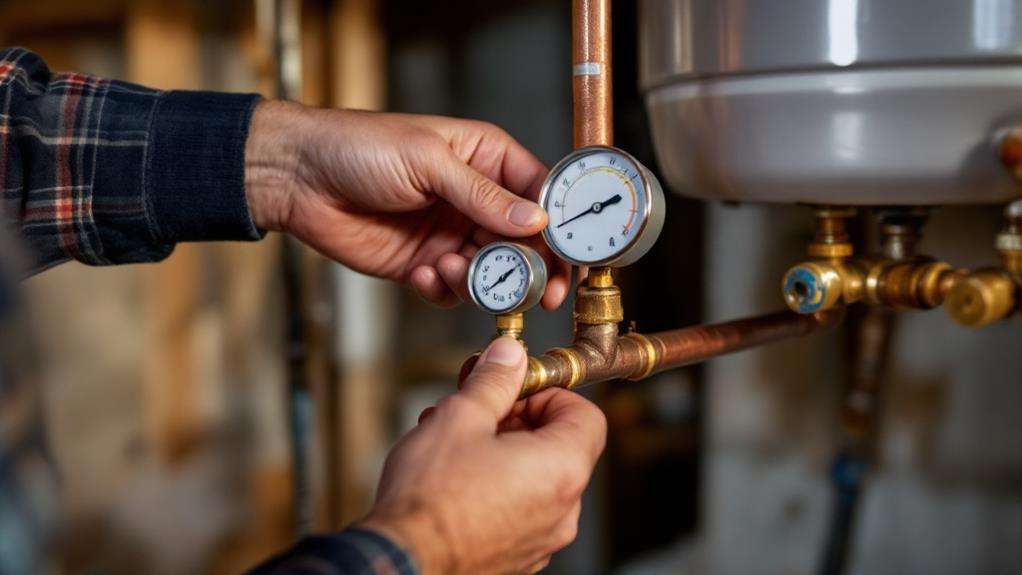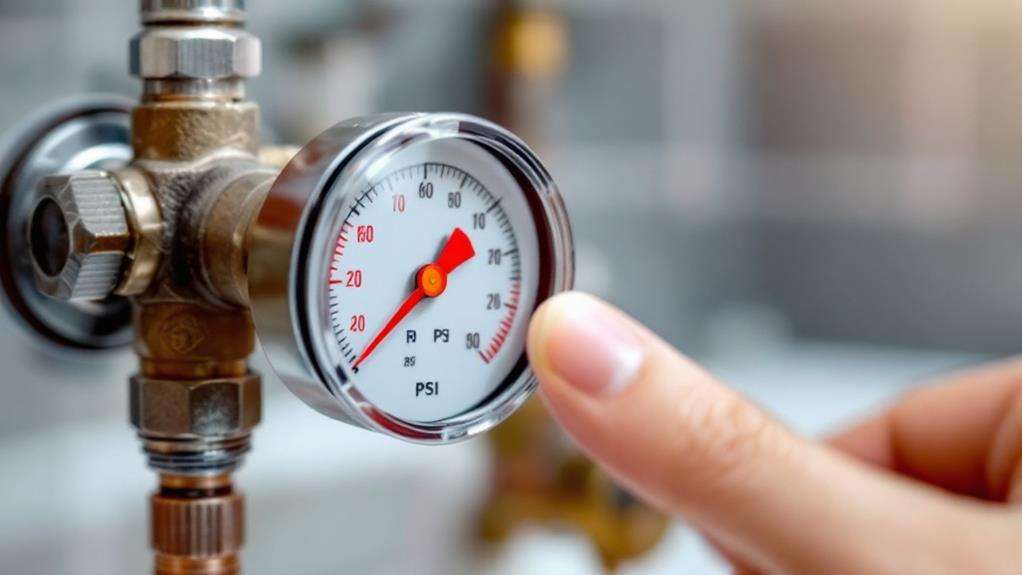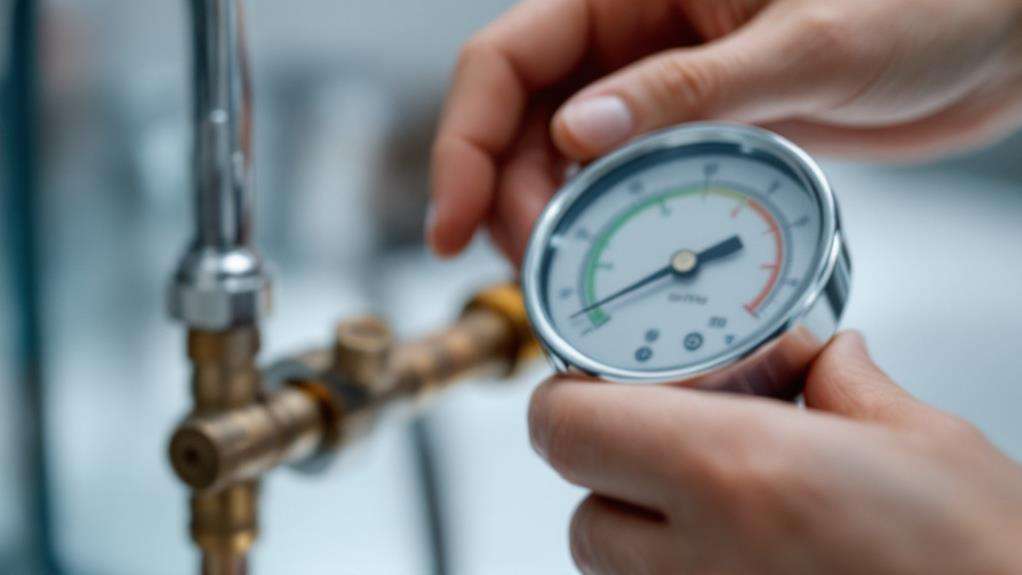How to Use a Pressure Gauge in Home Plumbing
To use a pressure gauge in home plumbing, start by choosing a gauge with a range up to 200 PSI and a 3/4-inch connector. Locate a test point near your main water supply, like an outdoor spigot or washing machine faucet. Safeguard no water is being used, then attach the gauge directly to the chosen outlet. Turn on the water and check the reading, aiming for 40-60 PSI. If it's outside this range, you may need to adjust your pressure regulator or address potential issues. Regular testing helps maintain ideal pressure and prevent plumbing problems. Explore deeper to become proficient in the art of managing your home's water pressure.
Understanding Water Pressure Basics
Understanding the basics of water pressure is indispensable for maintaining your home's plumbing system. Your main water supply delivers water at a specific pressure, which impacts the performance of your faucets, showers, and appliances. Ideal home water pressure ranges from 40 to 60 psi, with 50 psi being perfect for most households.
To guarantee your home's water pressure is within the ideal range, you'll need to use a pressure gauge. This simple tool allows you to Test the pressure at various points in your plumbing system. It's pivotal to maintain proper water pressure, as both low and high pressure can cause issues. Low pressure can lead to poor performance of fixtures and appliances, while excessive pressure (over 80 psi) can damage pipes and cause water waste.
Choosing the Right Pressure Gauge
Now that you're familiar with water pressure basics, let's focus on selecting the right pressure gauge for your home plumbing needs. When choosing a pressure gauge to test water pressure in your home, consider the following factors:
Range: Most homes water pressure gauges have a range up to 100 or 200 PSI, which is suitable for typical residential systems. This range allows you to accurately measure and monitor your home's water pressure.
Connector size: Look for a gauge with a 3/4-inch connector, as this size fits most garden hose spigots and outdoor faucets. Guarantee the gauge has female hose threads for direct attachment to these water sources.
Adaptability: If you need to test pressure at different plumbing fixtures, consider purchasing larger gauge sizes or adapters to accommodate various connection types.
Cost: Pressure gauges for home use typically range from $10 to $30. The price varies based on features and capabilities, so choose one that fits your budget and requirements.
When selecting a gauge to test water pressure, prioritize accuracy and ease of use. A reliable pressure gauge will help you identify potential issues in your plumbing system and assure proper water pressure throughout your home.
Locating Test Points in Your Home

For accurate pressure readings, you'll need to identify suitable test points in your home's plumbing system. The main water supply line or an outdoor hose spigot near the water meter are ideal locations to use a gauge to test your home's water pressure. These spots provide a reliable representation of your overall system pressure.
If you can't access these areas, consider using a faucet behind your washing machine. To do this, shut off the water and connect the pressure gauge directly to the outlet. However, avoid testing at interior faucets, as they may not accurately mirror whole-home pressure due to potential drops from fixtures.
When selecting a test point, look for a location close to where water enters your home. This guarantees easy access for installing the pressure gauge and obtaining an accurate pressure reading. For convenience and regular monitoring, you might want to install a dedicated test port with a ball valve near your Main Water Shutoff Valve. This setup allows for quick and easy pressure checks without disrupting your water supply or requiring repeated gauge installations.
Steps to Test Water Pressure
To test your home's water pressure accurately, you'll need to follow a few key steps. First, make sure no one's using water inside or outside your home. Then, attach a pressure gauge directly to an outdoor faucet near your main water supply. It's essential to use a gauge that reads in pounds per square inch (psi) and has female hose threads for an accurate reading.
Once the gauge is attached, check the pressure reading and compare it to the ideal range of 40-60 psi. If your pressure falls outside this range, you may need to adjust the water pressure. For an alternative testing method, you can use your washing machine's cold water connection. Shut off the faucet, set up a container and towel to catch any water, and disconnect the hose to test the pressure.
It's a good idea to perform regular water pressure tests to identify potential issues early and guarantee your appliances operate efficiently. By following these steps, you'll gain meaningful insights into your home's plumbing system and be better equipped to maintain optimal water pressure throughout your house.
Interpreting Pressure Gauge Readings

Once you've taken your water pressure readings, understanding what they mean is the next key step. Your pressure gauge provides vital insights into your home's plumbing systems. If the reading falls below 40 psi, you're dealing with low water pressure that could affect your appliances, including your Water Heater. This might result in weak showers or slow-filling toilets.
Ideally, you'll want to see readings between 40-60 psi. This range guarantees optimal performance for most household plumbing fixtures. However, if your gauge shows pressure above 75 psi, you're entering high-pressure territory. While you might enjoy strong water flow, it can potentially damage your plumbing over time.
Readings exceeding 80 psi are typically too high and may violate building codes. If you encounter such high pressure, consider installing a pressure regulator to protect your pipes and appliances.
Don't forget to monitor pressure trends over time. Sudden changes could indicate issues like filter clogs or alterations in your water supply system. By regularly checking your pressure gauge and interpreting its readings correctly, you'll maintain a healthy plumbing system and catch potential problems early.
Adjusting Your Home's Water Pressure
So you've identified an issue with your home's water pressure - what's next? If your pressure's too high, you'll need to adjust it to prevent potential water damage to your homes pipes and appliances. Start by locating your pressure regulator, typically found where the main water line enters your house. To lower the pressure, turn the adjustment screw counterclockwise. Make small adjustments, then recheck with your pressure gauge.
If your pressure's too low, first make certain there are no leaks in your water lines. Check all visible pipes and fixtures for signs of water. If you can't find any leaks, you may need to adjust the pressure regulator by turning the screw clockwise. However, be cautious not to exceed 80 psi, as this can cause damage.
For complex issues or if you're uncomfortable making adjustments yourself, it's best to call a licensed plumber. They can accurately diagnose the problem and make necessary repairs or adjustments. Remember, maintaining proper water pressure is indispensable for your home's plumbing health and efficiency, so don't hesitate to seek professional help when needed.
Maintaining Optimal Pressure Levels

Having established the correct water pressure for your home, maintaining preferred levels is essential for long-term plumbing health and efficiency. To guarantee optimal pressure, you'll need to check it regularly using a pressure gauge. Start by attaching the gauge to an outdoor spigot or any easily accessible faucet with a female hose connection. This bell-shaped device will give you an accurate reading of your home's water pressure.
Aim to keep your pressure between 40-60 psi for efficient appliance operation and to prevent premature wear on fixtures. If you notice pressure consistently above 80 psi, it's time to take action. High pressure can damage plumbing components and lead to water waste. Consider installing a pressure regulator to sustain levels within the recommended 40-75 psi range.
Don't forget to check outdoor faucets as well, as they can be particularly susceptible to pressure fluctuations. By monitoring your water pressure regularly, you'll catch potential issues early on and can make timely adjustments. This proactive approach will enhance your home's comfort, improve water usage efficiency, and protect your plumbing system from unnecessary wear and tear.
